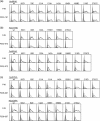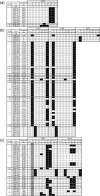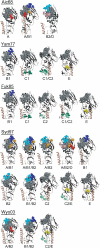Localization of epitopes recognized by monoclonal antibodies that neutralized the H3N2 influenza viruses in man
- PMID: 21068214
- PMCID: PMC3081080
- DOI: 10.1099/vir.0.026419-0
Localization of epitopes recognized by monoclonal antibodies that neutralized the H3N2 influenza viruses in man
Abstract
Through extensive isolation of neutralizing mAbs against H3N2 influenza viruses representing the in vivo repertoire in a human donor, we examined the relationships between antigenic drift of influenza virus and protective antibodies generated in an infected individual. The majority of mAbs isolated from a donor born in 1960 were divided into three major groups with distinct strain specificity: 1968-1973, 1977-1993 and 1997-2003. In the present study, we developed a new method that allowed us to comprehensively determine the location of epitopes recognized by many mAbs. Original haemagglutinins (HAs) of several strains and chimaeric variants, in which one of the seven sites (A, B1, B2, C1, C2, D or E) was replaced by some other strain-derived sequence, were artificially expressed on the cell surface. The binding activity of mAbs to the HAs was examined by flow cytometry. By using this method, we determined the location of epitopes recognized by 98 different mAbs. Clones that neutralize the 1968-1973 strains bind to site B2/D, A or A/B1. While sites C, E and B were recognized by clones that neutralized the 1977-1993 strains, the majority of these clones bind to site C. Clones that neutralize the 1997-2003 strains bind to site B, A/B1, A/B2 or E/C2.
Figures






Similar articles
-
Mapping of a Novel H3-Specific Broadly Neutralizing Monoclonal Antibody Targeting the Hemagglutinin Globular Head Isolated from an Elite Influenza Virus-Immunized Donor Exhibiting Serological Breadth.J Virol. 2020 Feb 28;94(6):e01035-19. doi: 10.1128/JVI.01035-19. Print 2020 Feb 28. J Virol. 2020. PMID: 31826999 Free PMC article.
-
Characterization of neutralizing epitopes in antigenic site B of recently circulating influenza A(H3N2) viruses.J Gen Virol. 2018 Aug;99(8):1001-1011. doi: 10.1099/jgv.0.001101. Epub 2018 Jun 26. J Gen Virol. 2018. PMID: 29944110 Free PMC article.
-
An analysis of the properties of monoclonal antibodies directed to epitopes on influenza virus hemagglutinin.Arch Virol. 1990;114(1-2):1-26. doi: 10.1007/BF01311008. Arch Virol. 1990. PMID: 1699509
-
[Molecular characterization of human influenza viruses--a look back on the last 10 years].Berl Munch Tierarztl Wochenschr. 2006 Mar-Apr;119(3-4):167-78. Berl Munch Tierarztl Wochenschr. 2006. PMID: 16573207 Review. German.
-
The antigenic architecture of the hemagglutinin of influenza H5N1 viruses.Mol Immunol. 2013 Dec;56(4):705-19. doi: 10.1016/j.molimm.2013.07.010. Epub 2013 Aug 7. Mol Immunol. 2013. PMID: 23933511 Review.
Cited by
-
An Anti-Influenza Virus Antibody Inhibits Viral Infection by Reducing Nucleus Entry of Influenza Nucleoprotein.PLoS One. 2015 Oct 29;10(10):e0141312. doi: 10.1371/journal.pone.0141312. eCollection 2015. PLoS One. 2015. PMID: 26512723 Free PMC article.
-
Viral receptor-binding site antibodies with diverse germline origins.Cell. 2015 May 21;161(5):1026-1034. doi: 10.1016/j.cell.2015.04.028. Epub 2015 May 7. Cell. 2015. PMID: 25959776 Free PMC article.
-
Influenza Hemagglutinin Nanoparticle Vaccine Elicits Broadly Neutralizing Antibodies against Structurally Distinct Domains of H3N2 HA.Vaccines (Basel). 2020 Feb 22;8(1):99. doi: 10.3390/vaccines8010099. Vaccines (Basel). 2020. PMID: 32098409 Free PMC article.
-
Potential Role of Nonneutralizing IgA Antibodies in Cross-Protective Immunity against Influenza A Viruses of Multiple Hemagglutinin Subtypes.J Virol. 2020 Jun 1;94(12):e00408-20. doi: 10.1128/JVI.00408-20. Print 2020 Jun 1. J Virol. 2020. PMID: 32269119 Free PMC article.
-
Naturally occurring antibodies in humans can neutralize a variety of influenza virus strains, including H3, H1, H2, and H5.J Virol. 2011 Nov;85(21):11048-57. doi: 10.1128/JVI.05397-11. Epub 2011 Aug 24. J Virol. 2011. PMID: 21865387 Free PMC article.
References
-
- Bebbington, C. R., Renner, G., Thomson, S., King, D., Abrams, D. & Yarranton, G. T. (1992). High-level expression of a recombinant antibody from myeloma cells using a glutamine synthetase gene as an amplifiable selectable marker. Biotechnology (N Y) 10, 169–175. - PubMed
-
- Gerhard, W., Yewdell, J., Frankel, M. E. & Webster, R. (1981). Antigenic structure of influenza virus haemagglutinin defined by hybridoma antibodies. Nature 290, 713–717. - PubMed
-
- Gerhard, W., Mozdzanowska, K., Furchner, M., Washko, G. & Maiese, K. (1997). Role of the B-cell response in recovery of mice from primary influenza virus infection. Immunol Rev 159, 95–103. - PubMed
Publication types
MeSH terms
Substances
LinkOut - more resources
Full Text Sources
Other Literature Sources
Medical
Miscellaneous

